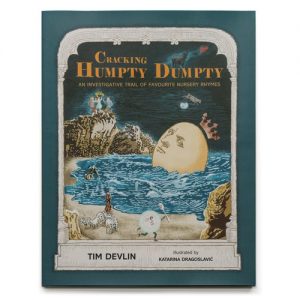When I was at teacher training college having a lovely time but not learning much about how to teach, one of the things they made us do was to create a book – not write one but create it as a craft exercise. And we could choose what to do or how to do it. Airy fairy stuff but I went off quite happily aged 19 to do this primary school task during the summer holidays – although I couldn’t see quite what I was going to gain or learn from it.
I’d found the books by Iona and Peter Opie in the college library and thought the history of nursery rhymes was interesting. So that became my hand-written book topic. A friend did the illustrations and most of the information came from the Opies. I didn’t get much of a mark for it although I really had tried. I’m simply not good at anything to with art and practical craft. The whole project, however, did teach me to view nursery rhymes in a different light and I’ve remained intrugued.
So imagine my glee when I discovered just before Christmas that Tim Devlin has just published Cracking Humpty Dumpty. His strapline is “an investigative trail of favourite nursery rhymes” and, a former journalist and then PR man, he really has applied his well honed professional research skills.
In fact he has debunked everything I thought I knew about nursery rhymes. Of course Ring-a-ring o’ roses isn’t really about the plague. It’s not mentioned in any of the contemporary sources or in respected historical accounts of the plague years. Rather the earliest references to it date from late 18th century Massachusetts in a game version a bit like musical chairs. The plague link stems, it seems, from a nineteen fifties book by James Leasor, a man with a colourful imagination. But the public liked the link and it soon became received truth particularly since the famous plague village, Eyam in Derbyshire understandably capitalised on it for tourism reasons. Fascinating stuff.
And we all know that “Little Boy Blue” was Cardinal Wolsey don’t we? Well hang on, he was a cardinal why wasn’t it Little Boy Red? Moreover, Wolsey was a very hard worker and not known for nodding off on the job. There is another theory that the eponymous lad was Charles II but a very similar rhyme in Shakespeare’s King Lear written over 50 years earlier refutes that. Or was it simply an unloaded comment on children who often guarded livestock on common land in the centuries before the enclosure acts? Sometimes the truth is much more straightforward than the fanciful interpretations commentators try to make fit.
Devlin investigate twelve rhymes in detailed depth. He writes smoothly and entertainingly but his book is packed with information. He has consulted dozens of books and other resources dated from 1837 to 2019 and spent hours in libraries and at relevant sites all over the country. It’s a pleasantly tactile book too in a nicely designed format by his publisher, Susak Press. The paper is shiny, the font a clear sans serif and the 190 x 240mm size slimly neat.
Katarina Dragoslavić’s warmly attractive illustrations are the icing on the cake. She nails the essence of Devlin’s arguments with a plate at the head of each chapter to which he often refers in the text.
The good news is that a sequel is in preparation. It will feature a further twelve rhymes and Devlin is inviting suggestions about which other rhymes he might investigate in the future.
At the time of writing, this excellent book is not available via Amazon although Devlin is hoping that it soon will be. Meanwhile you can purchase it via the website www.humptycracked.com.

Next week on Susan’s Bookshelves: My Theodosia by Anya Seyton